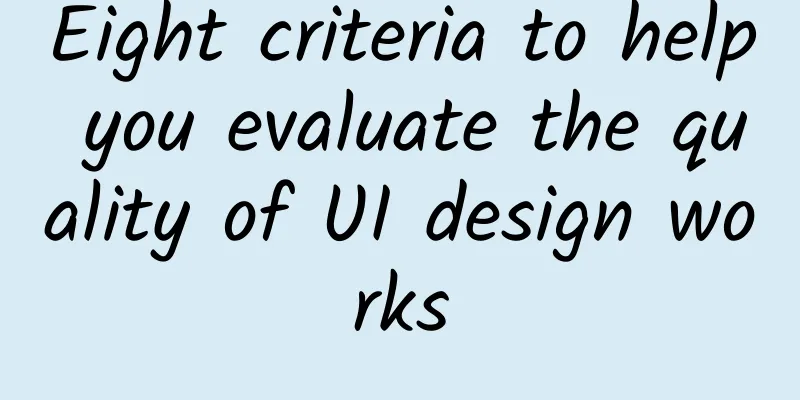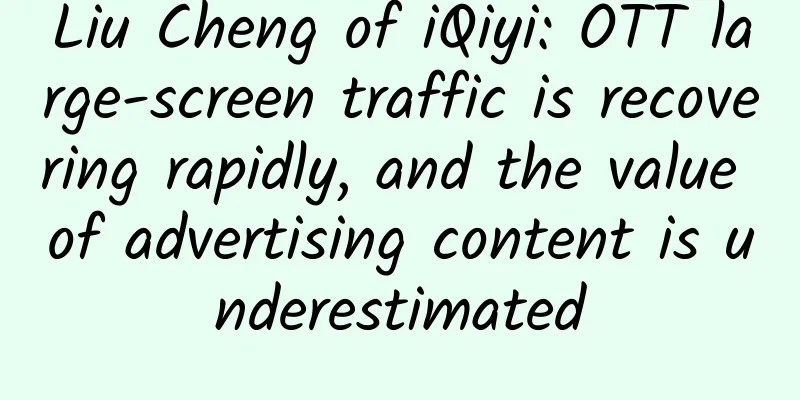Eight criteria to help you evaluate the quality of UI design works

|
A complete UI design is actually quite complicated, from demand analysis to market positioning, from drafts to proposed plans, from the combination of creative elements to the precipitation of ideas, from design specifications to breaking through traditions, from paper to computer, from individuals to teams, or from teams to individuals, from material collection to material processing, from zero ideas to chance, etc. In fact, designing something really, really, really encounters too many problems. With such a complicated process, what others see is just the "surface", and the designer will not expose his true inner thoughts. Therefore, most people cannot fully understand what a work really wants to express. Therefore, do not completely rely on the evaluation of others or self-evaluation for the quality of a work. Of course, there are still some basic premises for good or bad. With these premises, whether a work is good or bad is just a matter of taste. If there are no prerequisites, it's just a half-baked thing. No matter how much you talk about your own style, it's actually a little joke in the eyes of others, just a bit of stubborn escape. Here are some small standards that I personally think of. These are my own summary, not expert theory or network theory. Please refer to them carefully. I have summarized 8 points: 1. Color comfort If a picture looks all over the place, or is too simple to distinguish between the primary and secondary, or has too much saturation or a mismatched brightness to be visually comfortable, I think it will be unbearable to look at for a long time. Because what people see with their first eyes is the color of an object, not its shape. 2. The priority of text Any design work must convey information and ideas. If the fonts in a design are messy, the text size and thickness, and the spacing and line spacing do not have a "primary and secondary logic", it is difficult for me to dig out the information I want. Whether the design is cool and complex or simple and refreshing, it is far from enough to just display information. Every detail of the information and text determines the priority of the ideas that a design wants to convey. Remember, you want to guide others to see, not others to guide you to design. There is no real fixed text standard in the world, but the most basic thing is to let others see what your text is about. Therefore, the different colors between the texts can also make the texts stand out. 3. Information readability With a text foundation, handling the layout, color blocks, illustrations, backgrounds, etc. of each module well will make your information more readable. Don't follow your hobbies: I like cool, I like simplicity, I like elegance, I like idiots. Convey the information you want to convey most in your design work. Even if some information is ignored by others, you are still successful. If users don't even want to read it, and even the most basic information cannot be conveyed, then any style of the work is just verbal boasting. You have to determine your target users. Do you want to eat all over China, even the world, and the entire industry? Unless, there is no unless. If you want to learn more about text processing methods, click here: "Sharing Experience! Super Practical Text Processing Skills" 4. UI Recognition This is especially true for icons. Whether you design a flat, skeuomorphic, or Van Gogh-style design, it is not necessary to understand the meaning of the icon in 3 seconds. You also need to make people appreciate the beauty of the icon and roughly "know" what the icon is trying to convey. When designing a website banner or a page navigation, you need to consider recognizability. What connotation do you want to convey with this image? What is the intention of your graphic? These are all things that designers need to consider. 5. Interactivity and usability The above work is almost done, and the rest is to use it. Whether it is a mobile phone theme, website design, APP or game, you need to let others quickly get started, play it, use it, and even use it easily. Even if you use cool interactions that are not available in the Milky Way, or use rustic designs that are endangered on Earth, as long as your work is easy to use and of excellent quality, no matter how awesome it is, there are still some awesome things to see.
6. Communication of thoughts and life The appearance of a work can usually reflect a designer's attitude and state towards life, work and emotions from another level, so don't underestimate the power of a work. It may be a medium to convey your true inner thoughts. You may not have discovered it, but bystanders have already discovered you. So, designing something that fits into life is difficult, but also the easiest. Do you expose your most careless and annoying side in your design? Do you convey your most meticulous and intriguing side to the user? You can tell from one picture (of course, this doesn’t mean everything. You can’t tell what kind of person some designers are after looking at their works for a few days.)
7. Tiny details and tiny creativity Don’t say you created this thing, because God created it earlier than you. In UI design, a line, a pixel, a subtle difference in color saturation, a small gradient, a font choice, the size of the canvas, the thickness of the pen, these small details, although not everyone can say them, but they can be "seen in the heart and felt in the bones" at the first sight, so even if you don’t say it, details can be felt by anyone at the first time. Don’t ignore every little detail, it may be the fortress of your success, but also the sharp arrow that makes you fail at any opportunity. In the details, you can give birth to some small ideas, and small ideas create big ideas. Without details, how can we talk about creativity? It is just empty talk. 8. References to expressions in life A simple parallax, a simple fall, a simple glass breaking, a simple falling leaf, a simple angle arrangement of a piece of paper, a simple close or far shot of a pot of plants, these things can create endless ways of expression for you. Of course, this is also relatively difficult. Being able to integrate life into design requires accumulation and cannot be experienced in a day or two. If you want more summaries, then there are none for now, because my current level can only feel this much, and I can’t perceive more. Maybe I will be able to perceive more in the future, haha. Summary: Don't keep evaluating the quality of a design work. There is no good or bad work. It is the voice of every real designer. Different people have different tastes. Some basic small standards can show whether the designer has designed the work "good or bad". If you don't even try to meet some basic standards, maybe there is no need to evaluate the UI design work. Because the work does not intend for others to evaluate its quality. Why bother? |
<<: Google sells 5 million virtual reality headsets
>>: Ultrasonic sensor helmet lets you walk like a bat
Recommend
CATL financial report: CATL's revenue for the full year of 2024 is 362.012 billion yuan, down 9.70% year-on-year
According to recent news, CATL released its 2024 ...
Is pulse diagnosis in traditional Chinese medicine mysterious? There is actually this kind of physics knowledge behind pulse diagnosis
Source | Institute of Physics, Chinese Academy of...
Tips for saving money on Singles’ Day: Don’t buy these 4 kinds of snacks for your children because they are all “pseudo-healthy” foods
Although the prelude to Double Eleven has passed ...
There is nothing that a good night’s sleep can’t solve. Is there actually a scientific basis for this?
Whenever something annoying or sad happens, your ...
Is getting caught in the rain a life-saving measure to avoid lightning strikes? This study tells you the truth
What do you fear most on a rainy day? Many people...
The Great Voyage丨Were Tang Dynasty wooden sailing ships so advanced?
Rugao Tang Dynasty Wooden Sailing Ship In the &qu...
8 short video transaction scripts
You may have spent thousands of dollars listening...
Two key factors in user operation growth and customer acquisition!
Customer acquisition is the basis for evaluating ...
China Passenger Car Association: MADE Industry Research Price/Discount Index Trend Report in June 2023
The MADE Industry Research Price Index is publish...
Say “no” to excessive permissions requested by mobile apps
With the rapid development of mobile Internet, va...
How does noise, the "big devil" of sound, break people's defenses?
Have you ever been disturbed by noise? For exampl...
Asia Winter Science Popularization Issue 7丨Unlocking the code of Heilongjiang ice and snow fever: Technology engine fully driven
Heilongjiang: The technological power behind the ...
The "frozen" flowing water, the floating ice disks... Look, the crystal clear ice and snow wonder!
...
If you want to watch birds, you no longer have to wait by the window!
Author: Duan Yuechu In today's era of integra...
The most comprehensive summary of the solution for diverting traffic from TikTok to WeChat
Readers often ask the author how to divert Douyin...









